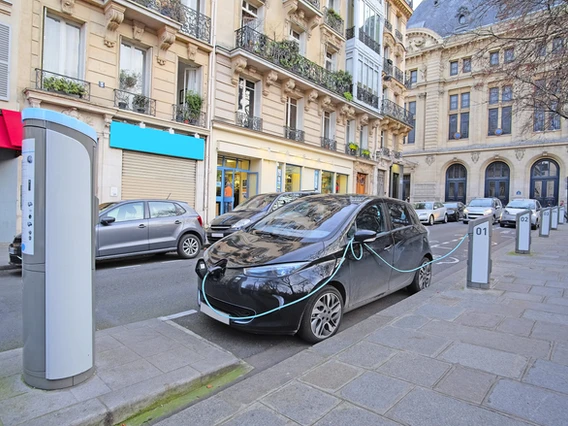Introduction
The UK Climate Change Act 2008 requires the UK to reduce greenhouse gas emissions by 78% in 2035 from 1990 levels (Committee on Climate Change, 2019; Harrabin, 2019; UK Government Act of Parliament, 2008 and others). The latest government statistics show a net reduction of 43% between 1990 and 2018. ‘The energy supply sector has accounted for around half of the overall reduction in UK emissions since 1990’ (Waite, 2019). Transport now accounts for the largest proportion of emissions at 28% of the total compared to the next biggest contributor, energy supply at 23% (Waite, 2019). Reduction of emissions from transportation is considered critical to meeting UK carbon reduction targets.
In this article, I will consider two technologies for the reduction of carbon from transport. The first technology is the conversion from Internal Combustion Engine Vehicles (ICEVs) to Electric Vehicles (EVs). The second is a much broader, diffuse, and integrated set of Information Communication Technologies (ICT) that enable remote working, reducing the need for a regular commute to a place of work. I shall refer to this technology generically as ICT enabled HomeWorking (ICTHW).
I will argue that the former is an extension of existing technological trajectories, supported through a combination of a top-down drive from automobile manufacturers and consumer-led demand, supported by existing government policy and related subsidies. The latter is the amalgamation of technologies, including hardware, software, societal/firm organisational structure, and general-purpose technologies such as the fast internet. ICTHW can be considered a socio-technological paradigm shift in response to the exogenous shock of COVID-19. I will compare and contrast technological pathways using the taxonomy of Pavitt, ‘Sectoral patterns of technical change’ (Pavitt, 1984), and extensions to this sectorial analysis by Tidd et al. and others (Tidd et al., 2005). I will conclude that the electrification of automobiles fits into the typical Chandlerian experience of how large firms innovate. In contrast, ICTHW is information-intensive and integration of services and products that could lead to an unintended economic shock.
Background to Energy Policy in the UK
To understand these two technological trajectories, we must first consider some features of the socio-economic environment for UK policy
(1) In its approach to carbon reduction, the UK is committed to a highly electric future, providing maximum flexibility to integrate less carbon-intensive power generation
(2) The importance of the car-industry to the UK economy, as well as the social desire for the freedoms that personalised transport affords.
(3) The UK is a modernised western economy dominated by the service sector, financial services and open-ended investment companies with a significant proportion of the UK population in office-based jobs (IBISWorld, 2020; UK Office for National Statistics (ONS), 2020a).
Based on these three factors, the UK is ripe for innovation in the electrification of transport and the decentralisation of the activities that occur in a traditional office.
Two technological solutions
Electrification of automobiles, a path-dependent technology

There are more than 32 million cars on UK roads (UK HM Government, 2020). The commercial market for automobiles is vast with around 1.2 billion automobiles on the world’s roads. The idea of EVs date back as far as 1832 (Opulous Innovation, 2019), and is not a new idea: ‘By 1890, one-third of all the vehicles within the US were electric powered (ibid)’. However, EVs were overtaken by ICEVs as the preferred technology due to the convenience of refuelling and flexibility of use. The production of ICEVs was revolutionised by Henry Ford in the early part of the 20th century, allowing scale-up and reduction in unit cost (Tomac et al., 2019), demonstrating the importance of production and process innovation in this sector. There have been more than 100 years of incremental innovation in products, process and manufacturing in the auto sector.
In the early 2000’s Toyota produced the first modern electric hybrid and Tesla started to produce high-performance electric cars. There has been a slow incremental growth in EVs and by 2018 one in twelve vehicles sold in the UK were electric, although ICEVs still dominate the global market.
The UK government has a stated policy of 100% translation to electric vehicles by 2040, with a recent announcement that sales of petrol and diesel cars will be banned in the UK from 2030 (Harrabin, 2020). The drive towards EVs is supported by government policy, with zero EV exercise duty and availability of government grants for the purchase of EVs and installation of electric charge-points (Government UK, 2020). This can be described as a demand side adoption subsidy of Steinmueller (Hall and Rosenberg, 2010, Chapter 28 p1193), specifically aimed at accelerating diffusion of EVs into the market.
Automobile manufactures have now embraced electrification (The Economist, 2018). Although currently more expensive than the internal combustion engine (ICE) ‘better technology and greater scale may soon allow EVs to compete on price’ (ibid). The strategy of developing EVs is relatively low risk, as The EVS and ICEVs can share the same platform and manufacturers are ‘hedging their bets by backing platforms—the basic architecture of a car—that are able to accommodate petrol and diesel engines as well as electric motors’ (ibid). Importantly, the EV market is large enough to attract competition and drive down costs for the consumer.
There are some additional spin-off technology opportunities for EVs that could assist with the overall decarbonisation strategy. For example, vehicle to grid (V2G) ‘allows EV batteries to store energy and discharge it back to the electricity network when it’s most needed’. (EDF, n.d.).
Information and Communication Technologies supporting HomeWorking (ICTHW)
In November 2020, statistics released by the UK’s Office for National Statistics showed ‘around half of the adults in employment were working from home, as a result of the social distancing measures introduced in response to the coronavirus pandemic’ (UK Office for National Statistics (ONS), 2020b). Regardless of the COVID effect, there has been a rising trend in working from home.
Innovations in computing, software, and services have facilitated this trend of homeworking. Examples of systems that support home working include:
(1) Cloud-based computing (opposed to physical hardware within a fixed office location)
(2) The rollout of fast internet services to consumer homes.
(3) Wireless telecommunication services, including the mobile phone fast WiFi, 4G and 5G services.
(4) Video-conferencing and online collaborative workspaces.
(5) Social media clone apps replacing email as the main form of business communication (Shameen, 2019).
Prior to 2020 and the COVID-19 crisis there ‘were factors which prevented the growth of homeworking before now. The first relates to information. Bosses simply did not know whether clustering in an office was essential or not. The past six months have let them find out’ (The Economist, 2020). The forced homeworking experiment of COVID, has revealed a past market failure to capitalise on the potential benefits of new IT inventions:

The potential for homeworking to reduce carbon emissions is evidenced by recently published statistics reported by Bloomberg (Petri, 2020). The Confederation of British Industry (CBI) has also recently responded positively to the benefits of ‘flexible working and localised shopping and the reimagining of offices0’ (CBI, 2020).
Discussion
We can consider the patterns of technological trajectory for the two technologies discussed, according to Pavitt (Pavitt, 1984) and Tidd (Tidd et al., 2005, Chapter 4).
Automobile manufacturing fits in the Chandlerian model of large companies characterised by professional-managerial capitalism that exploit economies of scale and build on existing product and production platforms (Teece, 1993). These large-scale companies employ the classic three-pronged strategy investing in manufacturing, distribution and management systems (ibid) to exploit the vast global automobile market. Profit attracts rivals and ‘potential entrants are driven by rational expectations based on expected profits’ (Santarelli and Vivarelli, 2007 p12). As stated earlier, new entrants may have more advantage in the market place, unencumbered by existing supply chains and creating new types of production systems for EVs that are simpler to assemble compared to ICEVs.
In Pavitt’s taxonomy, we can describe innovation in EV as being on a trajectory characterised by the specific sector of autos, dominated by large firms with high vertical integration (Table 1; Pavitt, 1984). Customers are both performance-sensitive and price-sensitive, and the market is large and diverse enough for firms to specialise in performance or price. EV manufacturers engage in both inhouse design and R&D and integrate with specialised suppliers. Product differentiation, production systems, design and marketing, are all technologically significant locus of innovation.
Manufacturers need to address a broad range of technological challenges to remain competitive in the face of new entrants (e.g. Ford versus Tesla). In the case of EVs the free market works effectively to promote innovation and drive down costs.
ICTHW is a heterogeneity of services and product integration. Pavitt’s original taxonomy has been criticised for being too focused on technology neglecting the heterogeneity of services (Gallouj 1999,2002). However, Tidd’s demonstrated that Pavitt’s taxonomy is still a useful framework of analysis by a simple extension to include information-intensive sectors, which include integrated software, hardware and services (Tidd et al., 2005 p 193).
ICT is an example of a shift from Fordist to post-Fordist models of organisation of production, and Vallas has discussed flexible specialisation and reorganisation of the workplace (Vallas, 1999). This organisational style has converted integrated hierarchical (manufacturing) companies into network-based corporations, outsourcing both manufacturing (software) and service activities in more complex systems of organisation and product delivery (Tidd et al., 2005). The providers are highly horizontally integrated, able to rapidly move into new products that combine to create a solution ecosystem (Jacobides et al., 2018).
ICTHW comprise both large and small firms offering both large and complex integrated ecosystems as well as more straightforward point solutions that fit into the ecosystem. From highly integrated suites, like Microsoft Azure, to the rising stars of smaller players like Zoom or Slack (CNBC, 2020). Innovation in this technological space is rapid, it is easy to invent, prototype, and produce new products; it is also easily imitated. There are hundreds of inventors in the market, with firms rapidly appearing and disappearing again (Shameen, 2019). This pattern is perhaps due to the newness of the products, and we are yet to see the sectorial mergers typical of more mature industries (Geroski, 1990; Santarelli and Vivarelli, 2007)[1], although we can point to Microsoft and a few others as the dominant players that are more Chandlerian in nature.
[1] On 02/12/2020, Slack was acquired by Salesforce for $27.7 billion https://www.bbc.co.uk/news/business-55154326
Paradigm Shifts
Dosi has described the importance of paradigm shifts in defining new technological trajectories (Dosi, 1982). I would argue that EVs is within the technical fit of existing manufacturers, although redesign to accommodate the EV drive-train could be described as revolutionary, a debatable point. Homeworking is an unexpected paradigm shift in societal patterns of working. The ICTHW revolution is probably best described as a paradigm shift (after Dosi , ibid) where automobiles are removed from the equation and so directly competes with the desired technology trajectory of vehicle manufactures and UK Government policy. The idea of eliminating personalised transport from the equation appears on more localised policy agendas, for example,

This paradigm shift implies a socio-technological change similar to Schot and Steinmueller’s ‘frame-3’ type policies that are more concerned with systematic social-innovation to solve climate change problems, rather than the artefact based technology of EVs (Schot and Steinmueller, 2018)
Conclusion
There are two potential solutions to the reduction of carbon from automobiles. The first is replacing ICEVs with EVs, and is within Pavitt’s technological class autos characterised by large Chandlerian professionally run firms with the market benefiting from the competition of new entrants attracted by large profits. I would argue that EV technology is within the current technological trajectory, supported by both UK Government policy and the economic weight of the automobile industry. This transformation is a ‘purposive transition and coordinated response’ (similar to Smith et al., 2005, p1502). The UK government have taken a pragmatic policy approach to incentivise take-up using demand-side subsidies of Steinmueller (Chapter 28 in Hall and Rosenberg, 2010). The main challenge for the Government is establishing a network of charge points sufficient to cope with the projected numbers of EVs (Clark, 2018). There is also a broader challenge that EVs are not entirely carbon zero – with significant carbon and environmental costs for EVs (Schwanen, 2019). Schott and Steinmueller pointed out that electric cars are just another form of lock-in that continues consumptive growth countering a low carbon economy:
The second solution, reduction or elimination of the use of the automobile through working from home is more problematic, as it is on the periphery of the policymakers radar. We might describe this as an ‘uncoordinated emergent transformation’ in response to an exogenous shock ‘lying outside the incumbent regime’ (similar to Smith et al., 2005, p1501). Therefore, the Government may not have considered fundamental changes to patterns of working as a solution to the transport problem. Reduction in office space and more a localised 15-minute city economy (London Borough of Hounslow, 2020), is much more disruptive innovation.
ICTHW is an ecosystem of technology that encompasses fundamental change in socio-technological regime similar to that described by Smith et. al. (Smith et al., 2005). This trajectory is an unintended consequence of the forced homeworking experiment of the COVID pandemic and is correcting past market failures to exploit ICTHW. However, we can identify some potential risks arising from ICTHW:
(1) Potential economic loss due to erosion of real-estate value as office space becomes redundant (further damaging the economy post-COVID);
(2) The decline and bankruptcy of firms supporting city-based office workers (i.e. food outlets); and
(3) A significant reduction in economic benefit from the UK car-industry.
The challenge for policymakers is to leverage both EVs and an overall reduction in the use of automobiles. Firms need to adjust to the idea of, and increased demand for, homeworking and the impact on organisational capability along with the challenges of integrating new technology unfamiliar to both firms and policymakers.
References
CBI, 2020. Covid-19 provides pathway to future of carbon reduction, flexible working and local shopping [WWW Document]. URL https://www.cbi.org.uk/media-centre/articles/pandemic-prompts-moves-towards-carbon-reduction-flexible-working-and-local-shopping/
Clark, J., 2018. UK needs 100,000 electric car charging points by 2020 [WWW Document]. NewCivilEngineer. URL https://www.newcivilengineer.com/latest/uk-needs-100000-electric-car-charging-points-by-2020-23-05-2018/#:~:text=The UK needs more than 80%2C000 extra electric,there are only 16%2C500 points in the UK.
CNBC, 2020. How Zoom became so popular during social distancing [WWW Document]. URL https://www.cnbc.com/2020/04/03/how-zoom-rose-to-the-top-during-the-coronavirus-pandemic.html
Committee on Climate Change, 2019. Reducing UK emissions – 2019 Progress Report to Parliament. Reducing UK Emiss. 2019 Prog. Rep. to Parliam.
Dosi, G., 1982. Technological Paradigms and Technological Trajectories: A Suggested Interpretation of the Determinants and Directions of Technical Change. Res. Policy 11, 147.
EDF, n.d. Drive for free with vehicle to grid [WWW Document]. URL https://www.edfenergy.com/electric-cars/vehicle-grid
Foxon, T.J., 2013. Transition pathways for a UK low carbon electricity future. Energy Policy. https://doi.org/10.1016/j.enpol.2012.04.001
Geroski, P.A., 1990. Innovation, technological opportunity, and market structure. Oxf. Econ. Pap. https://doi.org/10.1093/oxfordjournals.oep.a041965
Government UK, 2020. Low-emission vehicles eligible for a plug-in grant [WWW Document]. URL https://www.gov.uk/plug-in-car-van-grants
Harrabin, R., 2020. Ban on new petrol and diesel cars in UK from 2030 under PM’s green plan [WWW Document]. BBC News. URL https://www.bbc.co.uk/news/science-environment-54981425
Harrabin, R., 2019. Climate change: UK government to commit to 2050 target [WWW Document]. BBC News. URL https://www.bbc.co.uk/news/science-environment-48596775#:~:text=The UK already has a 2050 target -,government is %22net zero%22 greenhouse gases by 2050.
House of Commons, 2019. The motor industry: statistics and policy [WWW Document]. URL www.parliament.uk/commons-library %7C intranet.parliament.uk/commons-library %7C papers@parliament.uk%7C @commonslibrary%0D
HSO, 2020. 50% of UK workforce to work remotely by 2020 [WWW Document]. URL https://www.hso.co.uk/leased-lines/technology-news/homeworking-news/50-of-uk-workforce-to-work-remotely-by-2020
IBISWorld, 2020. Biggest Industries by Revenue in the UK in 2020 [WWW Document]. URL https://www.ibisworld.com/united-kingdom/industry-trends/biggest-industries-by-revenue/
Jacobides, M.G., Cennamo, C., Gawer, A., 2018. Towards a theory of ecosystems. Strateg. Manag. J. https://doi.org/10.1002/smj.2904
London Borough of Hounslow, 2020. A BOROUGH PLAN FOR RECOVERY [WWW Document]. URL https://www.hounslow.gov.uk/downloads/download/671/hounslow_council_borough_recovery_plan
Mattioli, G., Roberts, C., Steinberger, J.K., Brown, A., 2020. The political economy of car dependence: A systems of provision approach. Energy Res. Soc. Sci. https://doi.org/10.1016/j.erss.2020.101486
Opulous Innovation, 2019. A Brief History of Electric Cars [WWW Document]. URL https://www.opulous.co.uk/electric-cars-a-brief-history#:~:text=The exact date of the first electric car,the UK by Thomas Parker%2C a British inventor.
Pavitt, K., 1984. Sectoral Patterns of Technical Change: Towards a Taxonomy and a Theory. Res. Policy 13, 343.
Petri, J., 2020. Covid-19 Is Affecting Emissions on a Planetary Scale [WWW Document].
Bloomberg. URL https://www.bloomberg.com/news/articles/2020-05-08/covid-19-pandemic-cuts-carbon-emissions-changes-planet-earth
Santarelli, E., Vivarelli, M., 2007. Entrepreneurship and the process of firms’ entry, survival and growth. Ind. Corp. Chang. https://doi.org/10.1093/icc/dtm010
sapartners, n.d. The Importance and Impact of the UK Automotive Sector [WWW Document]. URL https://sapartners.com/importance-impact-uk-automotive-sector/ (accessed 11.18.20).
Schot, J., Steinmueller, W.E., 2018. Three frames for innovation policy: R&D, systems of innovation and transformative change. Res. Policy 47, 1554–1567. https://doi.org/10.1016/j.respol.2018.08.011
Schwanen, T., 2019. The five major challenges facing electric vehicles [WWW Document]. BBC News. URL https://www.bbc.co.uk/news/uk-49578790
Shameen, A., 2019. The rise of Slack and the death of corporate email [WWW Document]. Edge. URL https://www.theedgemarkets.com/article/tech-rise-slack-and-death-corporate-email
Smith, A., Stirling, A., Berkhout, F., 2005. The governance of sustainable socio-technical transitions. Res. Policy 34, 1491–1510. https://doi.org/10.1016/j.respol.2005.07.005
Steinmueller, W.E., 2010. The Economics of Technology Policy, in: Handbook of the Economics of Innovation: Volume 2. North Holland, Amsterdam, pp. 1181-1218 Steinmueller,.
Teece, D., 1993. The dynamics of industrial capitalism: Perspectives on Alfred Chandler’s Scale and Scope — Scale and Scope: The Dynamics of Industrial Capitalism by Alfred D. Chandler with Takashi Hikino. J. Econ. Lit. 31, 199.
The Economist, 2020. Covid-19 has forced a radical shift in working habits. Econ. Sept 12th.
The Economist, 2018. Big carmakers are placing vast bets on electric vehicles. Econ. Apr 17th.
Tidd, J., Bessant, J., Pavitt, K., 2005. Managing innovation [electronic resource] : integrating technological, market and organization change / Joe Tidd, John Bessant, Keith Pavitt., in: Managing Innovation: Integration Technological, Market and Organizational Change.
Tomac, N., Radonja, R., Bonato, J., 2019. Analysis of Henry Ford’s contribution to production and management. Pomorstvo. https://doi.org/10.31217/p.33.1.4
UK Government Act of Parliment, 2008. Climate Change Act 2008. UK Public Acts. 2008 Chapter 27, Her Majesty’s Stationery Office and Queen’s Printer of Acts of Parliament. UK Government.
UK HM Government, 2020. Department for Transport statistics. Vehicle Licensing Statistics [WWW Document]. URL https://www.gov.uk/government/collections/vehicles-statistics
UK Office for National Statistics (ONS), 2020a. Table 6: Workforce jobs by industry (seasonally adjusted) [WWW Document]. URL https://www.ons.gov.uk/employmentandlabourmarket/peopleinwork/employmentandemployeetypes/datasets/summaryoflabourmarketstatistics
UK Office for National Statistics (ONS), 2020b. Coronavirus and the social impacts on Great Britain: 13 November 2020 [WWW Document]. ONS. URL https://www.ons.gov.uk/peoplepopulationandcommunity/healthandsocialcare/healthandwellbeing/bulletins/coronavirusandthesocialimpactsongreatbritain/13november2020#impact-on-work
Vallas, S.P., 1999. Rethinking post-fordism: The meaning of workplace flexibility. Sociol. Theory. https://doi.org/10.1111/0735-2751.00065
Waite, C., 2019. 2018 UK Greenhouse Gas Emissions [WWW Document]. URL https://assets.publishing.service.gov.uk/government/uploads/system/uploads/attachment_data/file/863325/2018-final-emissions-statistics-summary.pdf





